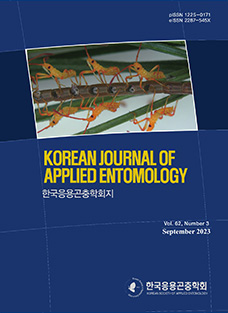The genus GreenideaSchouteden, 1905 includes 66 species in the world (Favret, 2025). The majority of species in this genus are mainly distributed in the South-East Asian region. Some of the species are important agricultural and horticultural pests; Greenidea (Trichosiphum) psidii van der Goot, 1917, Greenidea (Greenidea) ficicola Takahashi, 1921. These have been identified as invasive on a global scale (Liu et al., 2013). This genus consists of three subgenera, the GreenideaSchouteden, 1905 (28 species), ParagreenideaRaychaudhuri, 1956 (4 species) and TrichosiphumPergande, 1906 (34 species) (Favret, 2025;Eastop and Hille Ris Lambers, 1976). Host plants of the species belong to this genus are chiefly Fagaceae, besides Moraceae, Betulaceae, Juglandaceae, Myrtaceae, Rosaceae and Rubiaceae. Information on the life cycle is scarce, typically anholocyclic (Blackman and Eastop, 2025).
Currently, two species have been reported on South Korea (Paik, 1965;1972); Greenidea (Trichosiphum) kuwanai (Pergande, 1906) was recorded by Okamoto and Takahashi (1927), Greenidea (Trichosiphum) nipponica Suenaga, 1934 was recorded by Paik (1972). In 2023, Greenidea (Trichosiphum) nigra (Maki, 1917) was newly collected on Quercus glauca (Fagaceae) in South Korea. In this study, we report apterous viviparous female of Greenidea (Trichosiphum) nigra for the first time in South Korea and provide species descriptions, measurement, distributions, host plants.
Materials and Methods
Colonies of G. (Trichosiphum) nigra had been collected on Quercus glauca in 2023. The aphid samples were preserved in 95% alcohol and slide glass specimens were mounted on Canada balsam, following the method of Blackman and Eastop (2000) methods. Images and measurements were taken by LEICA (DM3000 LED) and LEICA (CTR6 LED). All specimens were deposited Institute of Agriculture & Life Science, Gyeongsang National University. The following abbreviations are used in morphological features: BL, body length from the head to the end of cauda; Ant., antennae; Ant.I-VI and Ant.VIb, antennal segments I-VI, and basal part of antennal segment VI, respectively; PT, processus terminalis; BDAnt.III, basal diameter of antennal segment III; 2HT, second segment of hind tarsus; HFM, hind femur; HTB, hind tibia; SIPH, siphunculus; SIPH BW, basal width of siphunculi; SIPH MW, maximum width of siphunculi; SIPH DW, distal width of siphunculi; Cauda BW, basal width of cauda; and URS, ultimate rostral segment.
Taxonomic Accounts
Genus GreenideaSchouteden, 1905: 181
Subgenus TrichosiphumPergande, 1906: 206
Greenidea (Trichosiphum) nigra (Maki, 1917) (Table 1; Figs.1, 2)
Trichosiphum nigrumMaki, 1917: 9, 10
Description. Apterous viviparous female.
Color in life. Body glossy reddish dark brown, except tibia and antennae; dark brown Ant.I, II; the distal end of Ant.III, Ⅳ; the distal half of Ant.V, VIb and the basal half of PT; Siphunculus black in life (Fig. 1).
Morphology. The body is brown pear-shaped, 2.11-2.89 mm long (Fig. 2A). Head and prothorax fused together. Antennae 6-segmented, pale brown except Ant.I-II, the distal end of Ant.V, VIb is brown; 1.52-1.96 mm long (Fig. 2G). Ant.III with 35-48 setae, weakly imbricated on the distal 1/3 of Ant.III; Ant.Ⅳ-V imbricated with 6-13, 5-7 setae; Ant.VI intensely imbricated with 4-7 setae on Ant.VIb; PT 0.28-0.42 mm long, with 3-4 short apical setae, 1.77-2.69 times as long as Ant.VIb. Ant.III 0.98-1.08 times as long as head width across eyes; the longest seta on antennal segment III is 0.17-0.21 mm long. URS 0.23-0.26 mm long, with 14-20 accessory setae; the basal of 4th rostrum segment passing the middle of hind coxae (Fig. 2D). Hind femur and hind tibia smooth, with many long and short setae together (Fig. 2C); 2HT brown, imbricated with 9-11 setae (Fig. 2E). Abdomen strongly spinulose ventrally; dorsal setae long and pointed; ventral setae short and pointed. Siphunculus is brown, with many long setae and spinulose; reticulated at the base (Fig. 2B); 0.28-039 times as long as BL, 7.54-9.56 times as long as basal width of SIPH. Cauda with 6-8 (mostly 6) setae (Fig. 2F); 0.35-0.44 times as long as Width of Cauda.
Specimen examined. 12 apterous viviparous females, Aewol-eup, Jeju-si, South Korea, 29.VIII.2023, on Quercus glauca, Y.-J. Kang, GNU.
Host plants. Quercus glauca (in this study), Q. acuta, Q. myrsinaefolia, Q. salicina, Lithocarpus edulis, L. formosanus. (Sugimoto, 2008;Raychaudhuri, 1956)
Distribution. South Korea (new record), Japan, Taiwan. (Miyazaki et al., 2016)
Key to species of the genus Greenidea in South Korea
-
1. Abdomen smooth ventrally. ··········································· ···························· Greenidea (Trichosiphum) nipponica
-
- Abdomen intensely spinulous ventrally. ······················ 2
-
2. Body dark brown; SIPH 0.2-0.3 times as long as BL. ···· ······························· Greenidea (Trichosiphum) kuwanai
-
- Body dark brown, reddish brown; SIPH 0.3-0.4 times as long as BL.· ················ Greenidea (Trichosiphum) nigra









 KSAE
KSAE





